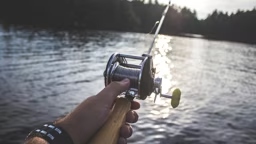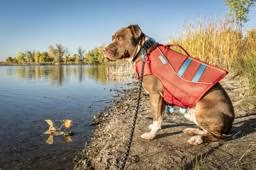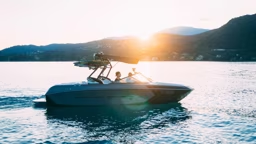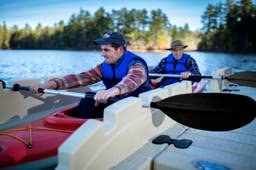
Stay Safe, Sport
No matter how old the child (or the inner child!), specially designed PFDs are required when it comes to water sports like tubing, wakeboarding or skiing. These are designed to stay in position when the wearer falls into the water. Yet, these PFDs are supple enough for the full body movement that’s needed when skiers or wakeboarders are doing tricks.
On the other hand, if angling is your sport, special PFDs are available with built-in tackle box pockets and fleece hand warmers.
On the other hand, if angling is your sport, special PFDs are available with built-in tackle box pockets and fleece hand warmers.
See also What You Need to Know About PFDs
Test Driving Your PFD
No matter what type of PFDs you purchase for family, practice wearing them in the water. A swimming pool or guarded swimming area is suggested. Let the kids find out how it feels to float in their vests. If you have chosen an inflatable, jerk the ripcord to learn what happens. It can be a bit of a surprise the first time. And reloading an inflatable PFD is a breeze with repacking kits and new CO2 cartridges; they’re available in most sports and marine stores.
Happy PFD shopping. Any extra money you spend on a cool looking model that you will actually wear is well worth the investment.
Happy PFD shopping. Any extra money you spend on a cool looking model that you will actually wear is well worth the investment.
Dorky and uncomfortable. That’s the way most of us feel about wearing a traditional orange life jacket. Not only are they hot, bulky and restrictive, but they’re not the most fashionable.
Maybe that stigma is why many people don’t wear a Personal Flotation Device (PFD).
Unfortunately, the majority of people who drown aren’t wearing a PFD. You never think it can happen to you, but it can. Today, there are great options for comfort, safety and even fashion, so there’s no reason not to wear one.
Maybe that stigma is why many people don’t wear a Personal Flotation Device (PFD).
Unfortunately, the majority of people who drown aren’t wearing a PFD. You never think it can happen to you, but it can. Today, there are great options for comfort, safety and even fashion, so there’s no reason not to wear one.
See also Boats, Lifts, Canopies & Curtains
Forgot I Was Wearing It
For more than two decades I’ve worn a PFD every day on my personal boat. My friends are mostly unaware that I am wearing one because my device is an inflatable belt pack that looks like any other pack a hiker or bicyclist might wear. Honestly, it’s so comfortable that I sometimes forget I have it on until I undress for bed.
Belt pack inflatables are for adults or older children who can swim well enough to keep their heads above water without the aid of a vest-style PFD. And you have to be capable of manually activating the inflator by pulling the ripcord or lanyard. Some models, like the Stearns Inflata-Belt Max, do come with an automatic inflation feature so that they blow up when submerged in water. But even automatic devices come with a manual back-up.
The importance of having emergency buoyancy when working or playing around water can’t be overstated. Most drownings occur after the victim accidentally falls into the water. In the majority of cases, the victim is within 10 to 15 feet of help, but potential rescuers can’t close that gap in time. Popping the belt pack can give you those extra moments of support you need to be rescued.
Belt pack inflatables are for adults or older children who can swim well enough to keep their heads above water without the aid of a vest-style PFD. And you have to be capable of manually activating the inflator by pulling the ripcord or lanyard. Some models, like the Stearns Inflata-Belt Max, do come with an automatic inflation feature so that they blow up when submerged in water. But even automatic devices come with a manual back-up.
The importance of having emergency buoyancy when working or playing around water can’t be overstated. Most drownings occur after the victim accidentally falls into the water. In the majority of cases, the victim is within 10 to 15 feet of help, but potential rescuers can’t close that gap in time. Popping the belt pack can give you those extra moments of support you need to be rescued.
No Kidding Around
Inflatable PFDs are not for kids, however. Not only are they more complicated to wear and operate, but they are also too big for young bodies. Conventional foam-filled PFDs for youngsters must be sized to the child’s weight and height. For a child, a poorly-fitting PFD can be as dangerous as none at all.Child-size vests span the post-toddler years until the child reaches 30 pounds in weight. Above that, youth vests provide coverage for children 50 to 90 pounds. Youth PFDs come in two sizes based on the child’s height.
Most states require children under a specified age (this varies from state to state) to wear PFDs while riding in open boats. These laws do not go far enough. In reality, when children are anywhere near water – docks, shoreline, boathouse – they should wear protection.
Toddlers need extra support to keep their mouths and noses out of the water until they grow stronger and more coordinated. So toddler and infant vests have large flotation collars to hold their heads out of the water. The best toddler PFDs also have a big loop on the collar to provide a handle for lifting the child from the water.
When buying an infant or child PFD always bring along the intended wearer. You may need to try several different styles on him or her before finding the best fit.
For older children (and reluctant spouses too!), you may wish to keep this in mind: They are less likely to fight wearing a PFD they helped pick out.
Stylish Too
A harness-style inflatable PFD offers better protection than a belt-style model, especially for weak swimmers, because it will help you hold your head above water. Made of lightweight nylon, it consists of a yoke-style collar around your neck. These are both cool in the hot sun and as cool-looking as high-tech sports apparel. Again, there are both auto-inflate and manual models.
And they really do work. My friend Charlie was aboard a 60-footer when it sprang a leak in the dead of night on Lake Erie, about 5 miles from shore in the deep water off the cliffs between Erie, Penn., and Buffalo, N.Y. He went below deck to toss up conventional PFDs to the others in the crew. Suddenly, the boat upended and Charlie was washed away into the darkness. As he went under the water, a comforting “whoosh” filled his ears. He popped to the surface. Hours later, the reflective tape on his inflatable caught the spotlight of a rescue boat, and he and his shipmates were rescued.
And they really do work. My friend Charlie was aboard a 60-footer when it sprang a leak in the dead of night on Lake Erie, about 5 miles from shore in the deep water off the cliffs between Erie, Penn., and Buffalo, N.Y. He went below deck to toss up conventional PFDs to the others in the crew. Suddenly, the boat upended and Charlie was washed away into the darkness. As he went under the water, a comforting “whoosh” filled his ears. He popped to the surface. Hours later, the reflective tape on his inflatable caught the spotlight of a rescue boat, and he and his shipmates were rescued.










